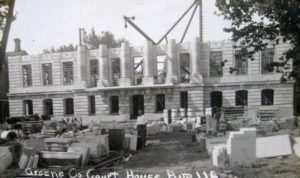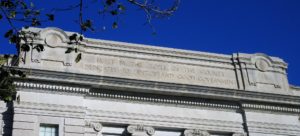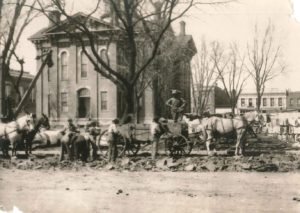“It is truly a work of art and engineering”
In this story of how it was designed and built, you discover why it is still sound and usable today. On Friday, Oct. 27, we celebrate its centennial.
by Don Van Gilder
Yes, I am biased when it comes to making a judgment about our Greene County courthouse in Jefferson. My grandfather was working for the county in the 1920s, building bridges and drainage systems. My brother worked in the county engineer’s office in the courthouse in the 1950s. I followed him there, part-time from 1965 to ’75, and fulltime since then. This 100-year-old building, which we’ll celebrate the centennial of this Friday, Oct. 27, means a whole lot to me.
In my view, it is truly a work of art and engineering, especially for the time in which it was built.
 I can’t imagine the workmanship and precision involved in constructing this building with the equipment available back in 1915-’17. There are good reasons why it is as sound and usable as it is today, and why in 1978 it won a place on the National Register of Historic Places.
I can’t imagine the workmanship and precision involved in constructing this building with the equipment available back in 1915-’17. There are good reasons why it is as sound and usable as it is today, and why in 1978 it won a place on the National Register of Historic Places.
Let me tell you about its style and how they built it.
Our courthouse is one of Iowa’s finest county courthouse designs, fashioned after the “Beaux Arts” style by Des Moines architects Proudfoot, Bird and Rawson.
In early February of 1915, the Greene County grand jury condemned the old red brick courthouse that was in use then, one that had been built in 1870. Their ruling was that the old building’s vaults were not fireproof and thus were unable to properly protect county records. That grand jury included S. Flack, Daniel E. Blanshan, J H. Marchant, E.C. Morain, Claus Nahnsen, William Knoll and W.H. Stevens. They suggested adding space on the east and west sides of the old building, and lining the old vaults with sheet steel.
However, the board of supervisors saw that suggestion as a temporary fix and “not in accord with good business judgment.” They passed a resolution calling for an election to issue bonds for $150,000 to erect a new courthouse. The forward-thinking supervisors who encouraged the county toward a new courthouse were A.E. Cole of Franklin Township, A.P. Fuhrmeister of Churdan, M.F. Fry of Rippey, Frank A. Newton of Jackson Township, and William Grivey of Dana.
The countywide vote passed by a nearly 2 to 1 margin, 1,330 to 708. Of note, a vote for a new courthouse in 1910 had failed 729 to 1,851. But the urgency in replacing the old courthouse had become clear when a chunk of stone coping fell from the top of one wall to the ground. It was displayed in O. L. Dick’s store window (where ShineOn Designs now operates).
 The Jefferson Bee newspaper celebrated the bond victory, stating: “Situated as this courthouse will be, on the greatest route of overland travel in the United States, there is nothing that the county could have done to advertise her progress and her prosperity as much as the replacing of the ancient courthouse by a new and modern building.”
The Jefferson Bee newspaper celebrated the bond victory, stating: “Situated as this courthouse will be, on the greatest route of overland travel in the United States, there is nothing that the county could have done to advertise her progress and her prosperity as much as the replacing of the ancient courthouse by a new and modern building.”
The opportunity to build a new courthouse gave notable architects the opportunity to make their mark on Jefferson. Proudfoot, Bird and Rawson was one of the busiest and best firms in the state. About the same time they won the courthouse job in Greene County, they were also doing courthouses in Jasper, Pocahontas and Polk counties; the buildings around Old Capitol on the Pentacrest at the University of Iowa, and many other public buildings across the state.
That company has grown into the firm known today as Brooks, Borg and Skiles, still in Des Moines, where the original plans and specifications for our courthouse are still held.
Bid opening was held Oct. 6, 1915. Bids had come from 18 general contractors, three for heating and plumbing, and five for wiring. After several days of discussion, the general contract was awarded to Rowles Company of Onawa for the sum of $127,372.
Heating/plumbing went to B. Grunwald of Omaha for $10,000. Electrical wiring went to McConnell-Langford Electrical Company of Boone for $1,875. Final construction costs for the building totaled $179,752.66.
It was claimed back then that no Iowa county had as good a courthouse for so low a price.
By using an inflation calculator converting to 2017 dollars, our courthouse would be a $3,437,573.02 project. But keep in mind that is based only the “purchasing power” of $179,752.66 in 2017, adjusted for the inflation rate. The actual building costs today would be tremendously higher, in the multi-million dollar range.
Ground was broken on the new courthouse on Nov. 3, 1915, with the first spade of earth turned for the basement and foundation of the new building.

It would be nearly two years before the new courthouse would be completed, and the county was now faced with the need to provide an interim courthouse to maintain county business.
The solution was to move the existing building west to Cherry Street (now Wilson Ave), place a new foundation and heating plant beneath it, and to use it until the new building was ready. Bids were taken and the E. W. LaPlant & Company of Cedar Rapids, along with the Shultz & Company of Jefferson, got the contract for moving the old courthouse for a bid of $4,500. Soon the old building was in its new location, up in the air, and the new foundation was being finished.
Once the old courthouse had been moved to its new location, work began on removing the old stone foundation. Jay G. Jackson, the “famous dynamite man,” as the newspapers referred to him back then, was brought in to dislodge some of the massive blocks. All went well until one blast put a brick through the Oppenheimer store window on the north side of the square, where Brooker & Company is located now.
The barrow from the massive foundation excavation piled up, and 2,500 loads of sand and gravel were mounded along the south and north sides.
These large mounds created an attractive nuisance for young boys using those “hillocks” as sliding places when it snowed. Their impetus would carry them into the street where vehicles were passing. A Bee article cautioned, “A rapidly moving auto and a small boy with a sled form a very undesirable kind of collision. It’s better to be safe than sorry.”
The first of 750,000 sub-wall bricks began to arrive in late January, 1916. An article in the Bee noted that none of these bricks would be in sight when the building was completed, for they would be used in backing up the stone walls, and for partitions only. These bricks can only be seen now in the basement and attic. In early spring, 1916, the exterior Bedford limestone from Indiana began to arrive by rail.
The worksite was fenced off to hold back the curious “sidewalk superintendents,” and the foundation work started in late March, 1916.
During the course of construction, parking around the square may have been limited. So in 1915 Capt. Albert Head leased an open portion of his property, the southwest corner off of the square, as a hitching rack area, having a capacity of 50 to 60 horses, and presumably some vehicles, too.
The cornerstone, located on the northeast corner of the building, was laid and dedicated on May 15, 1916. The officers of the Grand Lodge of Iowa Masons, along with members of the Masonic affiliates in Greene County towns, performed the formal ceremony.
The building’s superstructure ascended through the summer of 1916. The building was enclosed by late December. Throughout the summer, the contractors erected an extra-large derrick in order to hoist the heavy materials into place. The derrick was powered by a “donkey” engine, a portable steam winch.
As the building progressed, this derrick was moved to different locations and elevated to each floor to lift the heavy building components.
On the north and south gable fronts are two large clocks, five feet in diameter, for the use and benefit of the public. They almost didn’t get included in the final structure. It was deemed that it was not positively necessary for the clocks to be installed, and the big disks could have been boarded up and left “as blank as the face of an English dude,” the Bee reported on Aug. 30, 1916. “The Board of Supervisors felt that the expense of this fine new courthouse is pretty heavy this year, and are of the opinion, for the present, that the county should not incur the expense.”
The Bee concurred with this opinion, but nevertheless thought the clocks should be supplied. The newspaper then took it upon itself to raise the money for the clocks, costing $500 total for both. The editors expressed that it was a small sum for a few good and patriotic citizens to “dig up.” The Bee then proceeded to publish each week a “roll of honor” for all givers to the project. Any sum of $1 or more would be published along with the name of the donor. Many donations of $1, and up to large donations of $25, were received and published.
Most of the building materials, as I indicated earlier, were transported into Jefferson by train, and many building components were measured by the carload. Not always did construction go according to plan. The Bee February 16, 1916, refers to “a strike in the stone quarries is holding up shipment of materials of this kind for the new courthouse, although contractor Rowles expects the condition will be changed in time to prevent any delay in the building.”
The formal dedication of the building was delayed until Oct. 27, 1917, due to delays in the delivery of interior marble.
There are many interesting, modern and distinctive elements incorporated into this 100-year-old structure that truly make this a unique building.
As in many courthouses of the early 20th century, the interior is arranged around a central domed rotunda with stained glass. This stained glass dome rises 60 feet above the rotunda floor and serves as a light shaft, designed to illuminate the interior hallways.
The rotunda floor has a 14-foot diameter mosaic in ceramic tile, depicting the county seal with the theme “The Land of Plenty.”
Willard Zeller, of Franklin Township, and his Zeller Seed Company inspired this design when his seed corn won the “World’s Championship” at the San Francisco Exposition in 1915. Then, the State of Iowa bought 400 bushels of that eared corn from the Zellers to build a huge cornucopia at the San Francisco fair, launching Iowa’s reputation as “the corn state” with visitors who came from across the nation and around the world.
Greene Countians were so excited about the Zeller Company’s triumph that county officials decided to recreate the cornucopia in the mosaic on the ground floor of the new courthouse.
A special feature of the third floor is the “jury dormitory,” which originally had 12 beds for the jurors, along with a washroom and shower bath that are still there. This suited the need for amenities for the jurors – with only one bath and all staying in the same room – because only men were allowed to serve on the jury then!
The building also originally housed an interior clock system. A master clock, still in the auditor’s office, with 13 secondary clocks located in the principal offices, drove the Hahl Pneumatic Clock system.
A central vacuum cleaning system was included in the original construction, and hose connections can be found at numerous locations throughout the building, even though that central system is no longer used.
From the third floor, you can see the arches above you featuring wall murals depicting “the progress of civilization as recorded in Iowa.” They were painted by the artist William Peaco of the Andrews Decorative Company, of Clinton. On the west was originally “The Buffalo Hunt,” and later it was replaced in 1962, due to water damage from rain leaking through the stained glass dome. Local artist John Beardslee replaced it with a farm scene featuring a combine, and a city in the background. On the east is “The Modern Farm,” re-worked also due to rain damage in 1962 by artist Beardslee. On the north is the original “The Emigrants,” and on the south is the original “The Pioneers.”
In accordance with the previous courthouse condemnation for not properly protecting county records, each of the four offices on the second floor is provided with a fireproof vault containing steel fixtures for the protection of county records. Not a splinter of wood was used in the original construction of these vaults. The walls, floors and ceilings consist of solid reinforced concrete. The windows are steel casements made in Manchester, England.
The courthouse was built to serve and to endure. And, with good care and maintenance, it has.
However, the years were beginning to take a toll on the stained glass dome of the rotunda, and this past winter it was removed, panel by panel, and taken to Des Moines by The Stained Glass Store for repair. Some of the reinforcing bars were not attached any longer and showing signs of failure along with deterioration of the lead. This could have been a real disaster had it not been discovered and repaired.
While in Des Moines, each piece of the stained glass structure was taken apart, cleaned and replaced, then secured by restoration quality lead assuring another 100 years of service. Cost of repair, $109,640. Similar restoration was done to the stained glass dome in the courtroom in late 2014.
 Cost of both those projects was $140,080 – nearly what the whole courthouse cost when built.
Cost of both those projects was $140,080 – nearly what the whole courthouse cost when built.
Don Van Gilder, the author of this story, is assistant county engineer in Greene County and has become the unofficial historian of the building. You can write him by email at dvangilder@co.greene.ia.us.
